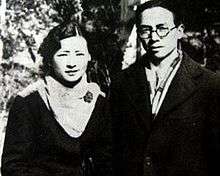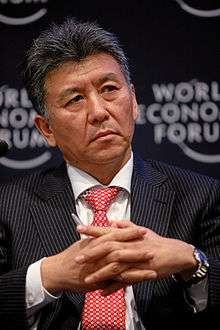Northeastern University (China)
|
东北大学 | |
_logo.svg.png) | |
| Motto | 自强不息,知行合一[1] |
|---|---|
Motto in English | Striving constantly for improvement, behave in conformity with truth. |
| Type | Public |
| Established | 1923 |
| Affiliation | Project 211, Project 985, Double First Class University Plan |
| President | Zhao Ji (赵继) |
| Party Secretary | Xiong Xiaomei (熊晓梅) |
Academic staff | 4,538 |
| Undergraduates | 29,872 |
| Postgraduates | 11,364 |
| 3,850 | |
| Location |
Shenyang, Liaoning, |
| Colors | NEU blue |
| Website |
english |
Northeastern University (NEU; simplified Chinese: 东北大学; traditional Chinese: 東北大學; pinyin: Dōngběi Dàxué) is a public university in Shenyang, Liaoning province with strengths in engineering and architecture. It is known for its prominent role in the information technology industry.
Having built China's first electronic analog computer, university research park, and university-run commercial enterprise, Northeastern is now part of a government plan to revitalize the Northeast China economy with a focus on high-tech manufacturing. Its alumni include the founder and CEO of Neusoft, the largest Chinese IT and software outsourcing corporation, the first Olympic athlete to represent China, in the 1932 Summer Olympics, and the founder of Amnesty International in Taiwan.
With a total enrollment of over 20,000 students, Northeastern has received significant government funding through the 211 Project and 985 Project, initiatives which sought to elevate the research standards of rising Chinese universities. In 2017, Northeastern was selected by the Chinese Ministry of Education as a Class B institution in the Double First Class University Plan, a major government initiative to comprehensively develop a group of elite universities into "world-class institutions" by 2050.[2]
History

Northeastern was founded on April 26, 1923 in Shenyang (previously known as Mukden), the capital city of Liaoning province, which at the time was the historic political and economic center of Northeast China. The institution attracted top scholars and teachers from throughout the region and quickly developed into a comprehensive university, with six schools for science, engineering, humanities, law, agriculture, and education.
In July 1928, the university was taken over by Marshall Peter Chang Hsüeh-liang (張學良, Zhang Xueliang), the military warlord known as the "Young Marshal" who controlled all of Northeast China at the time. Marshall Chang assumed the title of president and became the university's most important financial and political patron in its early history.
Less than a decade after it was founded, the university was forced to evacuate its campus following the Mukden Incident on 18 September 1931. After the incident, the Japanese invaded and annexed all of Northeast China, including Shenyang, and reorganized the region into the puppet state of Manchukuo.
Like many national universities in China during the Second Sino-Japanese War, Northeastern University was repeatedly displaced and re-established in several cities away from the front lines. During this time, the university was relocated to Beijing, Xi'an, and the city of Santai in Sichuan Province, before the war ended in August 1945.
The university returned to its original campus in Shenyang in February 1946.
After the establishment of the People's Republic of China on 1 October 1949, Northeast China became the beneficiary of substantial Soviet investment. The region became heavily industrialized and one of the most prosperous regions in China. Northeastern University was renamed Northeastern University of Technology in August 1950 and became primarily an engineering school.
By the 1990s, economic reforms had caused most of the nation's economic investment to shift to the Pacific Coast cities, such as Shanghai and Xiamen. While China in general became increasingly prosperous, factories throughout Northeast China closed and the region fell into an extended economic recession.
On 8 March 1993, the university reverted to its original name of Northeastern University.
In the past two decades, Northeastern University was selected to participate in the 211 Project and Project 985, nationwide government initiatives to expand and modernize the Chinese university system, including significant government funding and subsidies for constructing state-of-the-art academic facilities. The university is also part of the national government's initiative to replace Northeast China's heavy manufacturing industry with a modern high-tech manufacturing economy.
Academics
Northeastern University consists of the School of Liberal Arts and Law, the School of Business Administration, the School of Sciences, the School of Resources and Civil Engineering, the School of Materials Science and Metallurgy, the School of Mechanical Engineering, the School of Information Science and Engineering, Sino-Dutch School of Biomedical and Information Engineering, and the Department of Foreign Languages. It has 46 undergraduate programs, 53 master's degree programs, and 23 doctoral degree programs, as well as an adult education program.
Rankings
| University rankings | |
|---|---|
| Global | |
| Times World[3] | 801-1000 |
In 2017, Times Higher Education ranked the university within the 801-1000 band globally.[3]
Campus
There are currently two campuses in Shenyang and one campus in Qinhuangdao, Hebei province.
Northeastern's two campuses in Shenyang are referred to as South Lake Campus and Hun Nan Campus. The South Lake Campus was built in 1952 and spans 2.03 million square meters. The Hun Nan Campus was built in 2013 and occupies 0.94 million square meters.
The official name of its Qinhuangdao campus is Northeastern University at Qinhuangdao. The campus was built in 1976 and occupies 0.46 million square meters.
Notable people

Faculty
Zhang Xueliang, the warlord who controlled Northeast China during the Second Sino-Japanese War and instigated the Xi'an Incident, and was President of Northeastern University
Liang Sicheng, the "father of modern Chinese architecture", founded the Department of Architecture at Northeastern
Lin Huiyin (Phyllis Lin), the first female architect in modern China, taught in the Department of Architecture
Ding Lieyun, management scientist and educator, President of Northeastern University (2011-2014) and elected a member of the Chinese Academy of Engineering

Graduates
Liu Jiren '80, computer scientist and CEO of Neusoft Group (an acronym of "Northeastern University Software"), the largest IT and software outsourcing corporation in China
Bo Yang, author and dissident of the Kuomintang dictatorship during Taiwan's White Terror period, and founder of Amnesty International in Taiwan
Liu Changchun, sprinter who was the first athlete to represent China (as the Republic of China) in the Olympic Games during the 1932 Summer Olympics
Shan Tianfang, famous Chinese pingshu performer and member of the China Society for Literature Popular Research
Guo Xiaochuan, Chinese poet and communist Eighth Route Army soldier considered a leading figure in the "political lyric poetry" style
See also
- Neusoft Group (acronym of "Northeastern University Software"), the largest IT and software outsourcing corporation in China
- Double First Class University Plan, a major government initiative to cultivate an elite group of Chinese universities to "world-class" status by 2050
References
- ↑ "校标校名校训校风校歌". Archived from the original on July 14, 2014. Retrieved July 3, 2014.
- ↑ "教育部 财政部 国家发展改革委 关于公布世界一流大学和一流学科建设高校及建设 学科名单的通知 (Notice from the Ministry of Education and other national governmental departments announcing the list of double first class universities and disciplines)".
- 1 2 World University Rankings 2017-2018
External links
| Wikimedia Commons has media related to Northeastern University (China). |
Coordinates: 41°45′42″N 123°24′59″E / 41.76167°N 123.41639°E